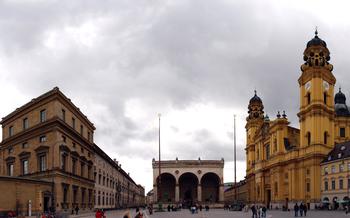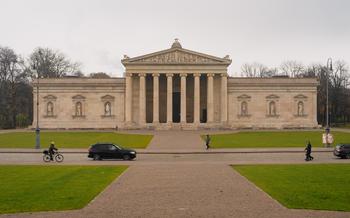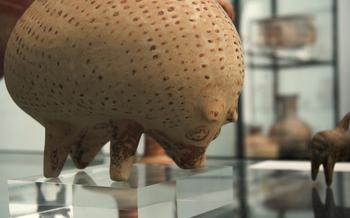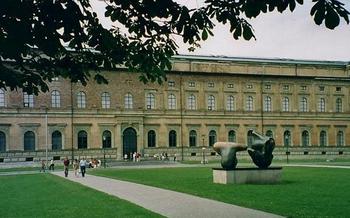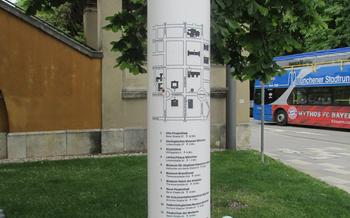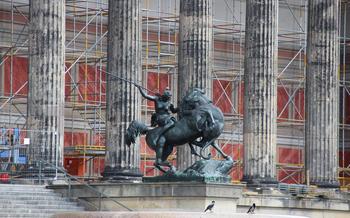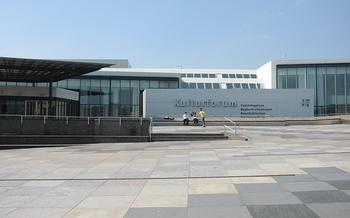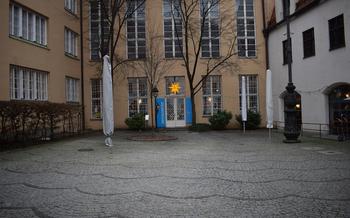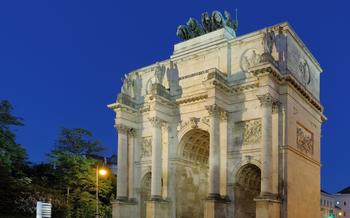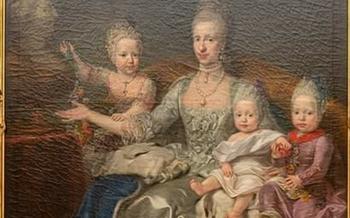
Königsplatz
- Königsplatz: A Place of Historical Significance
- The Glyptothek: A Treasure Trove of Classical Art
- The Alte Pinakothek: A Masterpiece of Art History
- The Staatliche Antikensammlungen: A Journey into Ancient Civilizations
- The Propyläen: A Gateway to Knowledge
- The Siegestor: A Symbol of Triumph
- Stroll Through the Königsplatz Gardens
- Attend a Concert or Performance at the Gasteig
- Grab a Bite to Eat at Königsplatz
- Take a Walking Tour of the Area
- Enjoy the Königsplatz Christmas Market
- Admire the Königsplatz at Night
- Visit the Königsplatz Museum Complex
- Learn About Munich's History at the NS-Dokumentationszentrum
- Insider Tip: Discover the Hidden Courtyard of the Alte Pinakothek
Königsplatz: A Place of Historical Significance
Königsplatz, situated in the heart of Munich, stands as a testament to the city's rich history and cultural legacy. Once a military parade ground, it was transformed into a grand public square in the 19th century, showcasing architectural wonders and significant historical landmarks. Embark on a journey through time as you explore this iconic square, where classical art, ancient civilizations, and modern cultural experiences converge.
Königsplatz played a pivotal role in Munich's urban development and political landscape. King Ludwig I, known for his passion for classical architecture and art, envisioned the square as a monumental ensemble dedicated to the arts and sciences. Under his patronage, renowned architects such as Leo von Klenze and Friedrich von Gärtner crafted magnificent buildings that adorned the square, creating a harmonious blend of neoclassical and Renaissance styles.
The Glyptothek: A Treasure Trove of Classical Art
The Glyptothek, a majestic neoclassical building, houses an impressive collection of ancient Greek and Roman sculptures. As you step inside, you'll be greeted by a breathtaking array of statues, busts, and reliefs that tell the story of classical antiquity.
One of the highlights of the collection is the Aegina Marbles, a series of well-preserved sculptures that once adorned the Temple of Aphaia on the island of Aegina. These exquisite works depict scenes from Greek mythology and offer a glimpse into the artistic achievements of the Archaic period.
Another must-see is the Barberini Faun, a life-size bronze statue of a satyr discovered in the 17th century. With its mischievous expression and dynamic pose, this sculpture is a testament to the artistic prowess of the Hellenistic era.
The Glyptothek also boasts a remarkable collection of Roman portrait busts, providing a fascinating glimpse into the faces of ancient emperors, statesmen, and ordinary citizens. These lifelike representations offer a tangible connection to the people who shaped the course of history.
Whether you're an art enthusiast or simply curious about the ancient world, the Glyptothek is a must-visit destination in Munich. Its treasures will transport you back in time, allowing you to experience the beauty and grandeur of classical civilization firsthand.
The Alte Pinakothek: A Masterpiece of Art History
The Alte Pinakothek, standing majestically on the northern side of Königsplatz, is a testament to Munich's rich artistic heritage. Established in 1836, this venerable institution houses a world-renowned collection of paintings spanning the Middle Ages to the Rococo period.
The walls of the Alte Pinakothek are adorned with masterpieces by some of the most celebrated artists in history. Gaze upon Albrecht Dürer's intricate and expressive "Self-Portrait" and marvel at the vibrant colors and meticulous detail of Peter Paul Rubens' "The Abduction of the Daughters of Leucippus."
Stroll through the grand halls and discover works by masters of the Italian Renaissance, including Raphael's serene "Madonna Tempi" and Titian's opulent "Venus of Urbino." Immerse yourself in the Dutch Golden Age with paintings by Rembrandt, Frans Hals, and Jan Vermeer, capturing the essence of the 17th-century Dutch society.
The Alte Pinakothek's collection extends beyond the European masters, showcasing works by Spanish artists such as El Greco and Francisco de Goya, as well as Flemish painters like Jan van Eyck and Rogier van der Weyden.
As you wander through the galleries, let the artworks transport you back in time, offering a glimpse into the artistic and cultural movements that shaped the past. The Alte Pinakothek is not merely a museum; it is a gateway to a world of creativity, inspiration, and artistic excellence.
The Staatliche Antikensammlungen: A Journey into Ancient Civilizations
The Staatliche Antikensammlungen (State Collection of Antiquities) is a treasure trove of ancient artifacts and sculptures, inviting visitors on a captivating journey through the civilizations of Greece, Rome, and Egypt. Founded in 1826, this museum houses an impressive collection of over 10,000 exhibits, providing a glimpse into the rich cultural heritage of these ancient worlds.
Among the highlights of the collection are stunning sculptures, including the famous Sleeping Satyr and the larger-than-life figure of the Roman emperor Augustus. The museum also boasts a remarkable collection of Greek vases, showcasing intricate designs and mythological scenes. Visitors can admire the delicate beauty of the Pan Painter's "White Lekythos" and marvel at the intricate details of the "François Vase", a masterpiece of Greek pottery.
The Egyptian collection offers a glimpse into the ancient civilization of the Nile Valley. Highlights include a monumental sandstone statue of the goddess Isis, as well as a collection of mummies and coffins, providing a fascinating glimpse into ancient Egyptian funerary practices.
A visit to the Staatliche Antikensammlungen is a journey through time, allowing visitors to experience the glory and grandeur of ancient civilizations. Whether you're an art enthusiast, a history buff, or simply curious about the past, this museum promises an unforgettable encounter with the wonders of antiquity.
The Propyläen: A Gateway to Knowledge
The Propyläen, a monumental gateway, stands as a testament to the architectural brilliance of the Königsplatz ensemble. Designed by Leo von Klenze, this neoclassical masterpiece serves as the grand entrance to the Alte Pinakothek, inviting visitors to embark on a journey through art history. Its imposing Doric columns, triangular pediment, and intricate friezes create a sense of awe and anticipation. The Propyläen's design echoes the Propylaea of the Acropolis in Athens, symbolizing the deep connection between Munich and the classical world. This architectural homage underscores the importance of preserving and celebrating ancient heritage and culture. The Propyläen not only serves as a physical gateway to the Alte Pinakothek but also as a metaphorical gateway to the realm of art and knowledge that awaits within its walls.
The Siegestor: A Symbol of Triumph
The Siegestor, also known as the Victory Gate, stands as a majestic monument at the western end of the Königsplatz. Commissioned by King Ludwig I in 1843 to commemorate Bavaria's victories in the Napoleonic Wars, this triumphal arch is a symbol of Bavarian pride and military prowess.
Designed by Friedrich von Gärtner, the Siegestor is an architectural masterpiece that draws inspiration from ancient Roman triumphal arches. Its imposing structure stands 21 meters tall and is adorned with intricate carvings and sculptures. The arch's four massive columns support a pediment featuring allegorical figures representing Bavaria, Victory, and Peace. The attic above the pediment is decorated with six statues representing famous Bavarian military leaders and statesmen.
The Siegestor has witnessed many significant events throughout history. In 1871, it was the site of a grand celebration to mark the unification of Germany under Prussian leadership. During World War II, the gate was damaged by Allied bombing but was later restored to its former glory. Today, the Siegestor remains an iconic landmark of Munich and a symbol of the city's rich history and resilience.
Stroll Through the Königsplatz Gardens
Amidst the grandeur of Königsplatz, the tranquil oasis of the Königsplatz Gardens offers a serene escape from the bustling city. These meticulously landscaped grounds invite visitors to amble along winding paths, discover hidden corners, and admire a diverse collection of sculptures.
The gardens were designed in the 19th century by the renowned landscape architect Friedrich Ludwig von Sckell, who sought to create a harmonious blend of natural beauty and classical elegance. Visitors can wander beneath towering trees, past blooming flower beds, and along the tranquil waters of the fountain, which serves as a centerpiece of the gardens.
As you stroll through the Königsplatz Gardens, take time to appreciate the exquisite sculptures that adorn the grounds. These works of art, created by renowned artists, depict a variety of subjects, from classical mythology to allegorical figures. Among the highlights are the "Sleeping Faun" by Adolf von Hildebrand, the "Bacchante with Infant Faun" by Franz Xaver Schwanthaler, and the "Lion Tamer" by August Gaul.
The Königsplatz Gardens are a delightful place to relax, reflect, and soak up the beauty of Munich's rich cultural heritage. Whether you seek a quiet moment of contemplation or a leisurely stroll, these gardens provide a serene haven in the heart of the city.
Attend a Concert or Performance at the Gasteig
The Gasteig cultural center is a renowned venue located just a stone's throw from Königsplatz. This architectural masterpiece is home to the Munich Philharmonic Orchestra, one of the world's leading ensembles. With its impressive acoustics and elegant ambiance, the Gasteig is a popular destination for classical music enthusiasts. Throughout the year, the center hosts a diverse range of concerts, from classical symphonies to contemporary compositions.
For those seeking a more theatrical experience, the Gasteig also features a state-of-the-art theater that stages a variety of performances, including plays, dance productions, and operas. The theater's diverse programming attracts both local and international artists, ensuring a vibrant and eclectic lineup of shows. Whether you're a fan of classical music, theater, or dance, the Gasteig offers an unforgettable experience in the heart of Munich's cultural scene.
Grab a Bite to Eat at Königsplatz
After a day of cultural exploration and museum hopping, satisfy your appetite at one of the many charming restaurants and cafés surrounding Königsplatz. From traditional Bavarian cuisine to international flavors, there's something to suit every palate.
Indulge in hearty Bavarian specialties at Augustiner-Keller, the oldest tavern in Munich, known for its convivial atmosphere and mouthwatering dishes like schnitzel and dumplings. For a taste of Italian cuisine, head to Trattoria Da Sergio, a local favorite serving up authentic pasta dishes, pizzas, and traditional Italian desserts.
Vegetarians and vegans will find plenty of options at Bio-Stüberl, which offers a delightful array of organic and seasonal dishes. For a quick bite and a caffeine fix, stop by Café Königsplatz, a cozy spot with a relaxed ambiance and a tempting selection of cakes, pastries, and freshly brewed coffee.
As you savor your meal, take a moment to soak in the vibrant atmosphere of Königsplatz. Watch the world go by as you people-watch from a café terrace, or find a quiet corner to enjoy a picnic surrounded by the square's architectural grandeur.
Take a Walking Tour of the Area
To delve deeper into the history and stories behind Königsplatz, consider joining a guided walking tour. Knowledgeable guides will lead you through the square and its surroundings, sharing fascinating anecdotes and insights. Alternatively, you can opt for a self-guided tour, exploring at your own pace with the help of a map or guidebook. As you wander, keep an eye out for hidden gems like the Justizpalast (Palace of Justice), with its intricate facade and grand staircase. Discover the stories behind the monuments, such as the tragic tale of the Wittelsbach Fountain, originally intended to commemorate King Ludwig II but ultimately left unfinished due to his untimely death. The nearby Karolinenplatz also offers a glimpse into Munich's past, with its elegant buildings and historical significance.
Enjoy the Königsplatz Christmas Market
During the festive season, the Königsplatz transforms into a magical winter wonderland, hosting the renowned Königsplatz Christmas Market. The square comes alive with the sights, sounds, and scents of the holiday season, attracting visitors from near and far.
Stroll through the rows of charming wooden stalls adorned with twinkling lights and festive decorations. Browse a wide array of unique gift ideas, from traditional Bavarian crafts to handmade ornaments and trinkets. Indulge in mouthwatering local treats, such as gingerbread cookies, roasted chestnuts, and Glühwein, a warm, spiced mulled wine.
Immerse yourself in the festive atmosphere as carolers fill the air with their melodious voices and the scent of roasted almonds and cinnamon wafts through the square. Discover hidden treasures and one-of-a-kind gifts that will make your holiday shopping truly special.
Whether you're looking for a unique souvenir or simply want to soak up the festive spirit, the Königsplatz Christmas Market is a must-visit during the holiday season. Embrace the magic of the season and create lasting memories in this enchanting winter wonderland.
Admire the Königsplatz at Night
As the sun sets over Munich, the Königsplatz transforms into a magical realm of illuminated landmarks and captivating views. The floodlights cast a warm glow on the majestic buildings, highlighting their architectural details and grandeur. The Propyläen, with its imposing columns and pediment, stands tall and proud, its silhouette etched against the starry sky. The Siegestor, adorned with intricate sculptures, exudes an aura of triumph and glory.
Strolling through the Königsplatz at night offers a unique perspective on this historic square. The absence of daytime crowds allows for a more intimate and awe-inspiring experience. Take your time to admire the intricate carvings on the Glyptothek's facade, marvel at the sheer size of the Alte Pinakothek, and appreciate the serene beauty of the Staatliche Antikensammlungen.
For photography enthusiasts, the Königsplatz at night presents a treasure trove of opportunities. Capture the dramatic contrast between the illuminated buildings and the dark sky, creating stunning silhouettes and long exposure shots. Experiment with different angles and perspectives to capture the essence of this iconic square.
Whether you're a history buff, an art enthusiast, or simply a traveler seeking magical experiences, the Königsplatz at night is not to be missed. Immerse yourself in the enchanting atmosphere, soak in the beauty of the illuminated landmarks, and create lasting memories of your time in Munich.
Visit the Königsplatz Museum Complex
The Königsplatz is not just a square but a cultural hub that encompasses several significant museums. Consider purchasing a combined ticket to access multiple museums and make the most of your visit. The Glyptothek, Alte Pinakothek, Staatliche Antikensammlungen, and the Propyläen are all part of the Königsplatz Museum Complex. With this ticket, you can embark on a journey through art history, from ancient sculptures to Renaissance masterpieces and Egyptian antiquities. Allocate a full day to explore these museums, allowing ample time to appreciate the treasures they hold. Plan your visit during the museum's extended hours on certain days to avoid crowds and fully immerse yourself in the cultural wonders of the Königsplatz.
Learn About Munich's History at the NS-Dokumentationszentrum
For a deeper understanding of Munich's past, visit the NS-Dokumentationszentrum, located near Königsplatz. This museum delves into the dark chapter of Nazi Germany's history and its profound impact on the city. Through thought-provoking exhibits, the museum sheds light on the rise of the Nazi regime, its propaganda, and the atrocities committed during World War II. Visitors can gain insights into the lives of victims, perpetrators, and resistance fighters, confronting the complex history of this period. The NS-Dokumentationszentrum offers a poignant reminder of the horrors of the past and serves as a powerful educational resource for future generations.
Insider Tip: Discover the Hidden Courtyard of the Alte Pinakothek
Beyond the grand halls and masterpieces of the Alte Pinakothek lies a hidden gem—a serene courtyard nestled within the museum's walls. Step through the unassuming doorway to find yourself transported to a tranquil oasis, where time seems to slow down.
The courtyard is a testament to the museum's rich history. Built in the 19th century, it served as a sculpture garden, displaying classical statues among lush greenery. Today, it retains its charm, offering visitors a peaceful retreat from the bustling city.
Amidst the tranquil atmosphere, you'll find hidden treasures. Sculptures of mythological figures and ancient deities adorn the courtyard, each telling a story from the annals of art history. Take a moment to admire their intricate details and let your imagination wander.
As you stroll through the courtyard, notice the architectural elements that blend seamlessly with the natural surroundings. Arched walkways, columns, and a central fountain create a harmonious ensemble that invites contemplation and serenity.
The courtyard of the Alte Pinakothek is a secret sanctuary, a place to escape the crowds and immerse yourself in the beauty of art and history. Whether you're an art enthusiast or simply seeking a moment of tranquility, this hidden gem is a must-visit.
